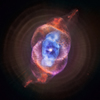CXC Home | Search | Help | Image Use Policy | Latest Images | Privacy | Accessibility | Glossary | Q&A
Tour of Cat's Eye Nebula
Quicktime MPEG
This composite of data from NASA's Chandra X-ray Observatory and the Hubble Space Telescope is another look for NGC 6543, better known as the Cat's Eye nebula. This famous object is a so-called planetary nebula that represents a phase of stellar evolution that the Sun should experience several billion years from now. When a star like the Sun begins to run out of fuel, it becomes what is known as a red giant. In this phase, a star sheds some of its outer layers. A fast wind streaming away from the hot core rams into the ejected atmosphere, pushing it outward, and creating the graceful filamentary structures seen with optical telescopes. In the case of the Cat's Eye, material shed by the star is flying away at a speed of about 4 million miles per hour. The hot core left behind will eventually collapse to form a dense white dwarf star.
Chandra's X-ray data of the Cat's Eye, which are seen as blue in this image, show that its central star is surrounded by a cloud of multi-million-degree gas. Structures in optical light by Hubble are colored red and purple. By comparing the two, astronomers determined that the chemical composition in the region around where the hot gas is found is like that of the wind from the central star, but it is different from the cooler outer material.
[Runtime: 01:25]
Quicktime MPEG
This composite of data from NASA's Chandra X-ray Observatory and the Hubble Space Telescope is another look for NGC 6543, better known as the Cat's Eye nebula. This famous object is a so-called planetary nebula that represents a phase of stellar evolution that the Sun should experience several billion years from now. When a star like the Sun begins to run out of fuel, it becomes what is known as a red giant. In this phase, a star sheds some of its outer layers. A fast wind streaming away from the hot core rams into the ejected atmosphere, pushing it outward, and creating the graceful filamentary structures seen with optical telescopes. In the case of the Cat's Eye, material shed by the star is flying away at a speed of about 4 million miles per hour. The hot core left behind will eventually collapse to form a dense white dwarf star.
Chandra's X-ray data of the Cat's Eye, which are seen as blue in this image, show that its central star is surrounded by a cloud of multi-million-degree gas. Structures in optical light by Hubble are colored red and purple. By comparing the two, astronomers determined that the chemical composition in the region around where the hot gas is found is like that of the wind from the central star, but it is different from the cooler outer material.
[Runtime: 01:25]
(Credit: X-ray: NASA/CXC/SAO; Optical: NASA/STScI)
Return to NGC 6543 (July 30, 2008)



